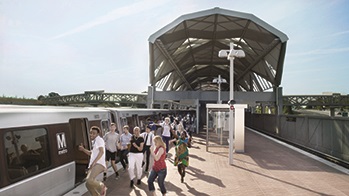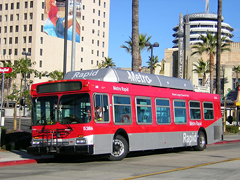This year, the Washington Metropolitan Area Transit Authority (Metro) decided that a ribbon-cutting alone would not suffice. The agency announced the opening of the first phase of its long-awaited Silver Line—a heavy rail extension through the suburbs and edge cities of northern Virginia—with a singular video. In it, suburbanites are roused from their homes by an irresistible groove. They dance, in an awkward flash mob, across their lawns, down the street, up a set of stairs and right into a waiting train. Once seated, goofy smiles and toe-tapping persist.
Metro’s tagline: “Good times are ahead.”

Excited riders dance their way on to the Washington, D.C., Metro’s
Silver Line in a still frame from a recent commercial.The distance from the District to Reston is nothing compared with the distance that transit agencies have traveled of late to enhance their appeal to customers. For the majority of the history of public transit, agencies have followed the lead of William Mulholland, who built the Los Angeles aqueduct. Upon opening the gates in 1913, he told the people of Los Angeles, “There it is. Take it.”
Of course, no one needs to be convinced to use water. Public transit, though, struggled throughout the second half of the 20th century. Ridership plunged with widespread adoption of the automobile. Nationwide, ridership had been in steady decline since the 1950s. But 2013’s 10.7 billion boardings matched a number that hadn’t been seen since 1956, although the country’s population then was 60 percent of its current size.
Today, transit agencies are abandoning the passive approach to ridership. A confluence of design technologies, communication technologies, new trends in urban development and—perhaps most importantly—
a cultural shift among young, smartphone-wielding city-dwellers has led to a new, more sanguine approach to the promotion of transit.
The notion of “branding”—which often encompasses or is accompanied by marketing, advertising, and communications (both internal and external) is famously vague. In the “Mad Men” era, features like packaging and slogans were used to differentiate between otherwise identical products, such as laundry detergent. Identifying the type of customer who would purchase Tide over Cheer was at least as important as describing the products themselves.
In transit terms, branding covers a wildly diverse array of components. It includes everything from the name and logo of the agency itself to signage, documents, electronic media, rolling stock, livery, drivers’ uniforms, and, of course, advertisements.
“I like to look at the brand as any touch point a customer has with anything that you have your brand name on,” said Bob Virkelyst, supervisor of marketing and service information at King County Metro, of Seattle. “That is indeed what you’re branding, whether it’s visual, audible or tactile.”
L.A. Makes Transportation ‘Cool’


Images courtesy of Metro. ©2014 LACMTA
Top, Los Angeles Metro’s move to wrap its Rapid
line buses in deep red helped distinguish them
from local buses. Above, a series of Metro ads
associates driving with negative words and transit
with positive words.The revolution in transit branding began, ironically, in Los Angeles. With each mile of freeway that was constructed from the 1950s onward, the Southern California Rapid Transit District sunk deeper into irrelevance. The agency was eventually reborn as the Los Angeles Metropolitan Transportation Authority. Metro hired Michael Lejeune in 2003 as its creative director—the first such position in the country. His charge: to wipe away all memory of RTD.
“I have one motto to myself: constantly trying to make Metro cool,” said Lejeune. “In a place like Los Angeles, if you don’t make transportation cool in some way [it won’t work].”
“I think that’s a mantra that any agency can use,” said Lejeune. “It’s particularly important here because we are the car capital and the influence of entertainment and technology. We have pretty stiff competition.”
Lejeune and his team scored a string of early victories. Graphics were updated on every bus, website, and piece of paper. For the first time, the agency invested heavily in advertisements, mainly handsome billboards with bright colors, clean graphics, and provocative catch phrases—such as “Problem” and “Solution” paired, respectively, with images of a gas pump and the Metro logo—designed to get Angelenos to change their minds about public transit. In 2005, Metro rolled out its then-revolutionary Rapid Buses in an equally revolutionary deep red design to instantly distinguish them from local buses.
“We give people interesting words and images together to think about,” said Lejeune. “It’s not that sort of bloodless transportation talk that I think a lot of agencies can fall into.”
Lejeune acknowledged that it’s almost impossible to quantify the amount of increased ridership—if any—that can be attributed to Metro’s branding efforts. And yet, he is convinced that it’s crucial. He said that the ultimate payoff was the 2008 passage of Measure R, a $30 billion funding program that had to meet California’s brutal two-thirds approval threshold for new local taxes. It passed with 67 percent of the vote. Lejeune calls that vote “our ultimate test of brand loyalty.”
Persuading New Riders
Metro remains the nation’s most comprehensive in-house design studio. But the principles that its studio embodies are catching on.
Connect Transit of Bloomington- Normal, Illinois, recently rebranded itself, starting with its logo. The change took some community members by surprise.
“The old [logo]…was just tired. It was a white or navy blue picture of a bus driver,” said Jennifer Sorenson, media relations manager for Connect Transit. “I’ve had different people around town come up and say, ‘I didn’t know Connect Transit was here…did we get a new bus company?’ No, we just rebranded.”
From the standpoint of corporate culture, getting transit agencies to embrace innovative marketing techniques entails a serious shift of gears. For most of their history, transit agencies have focused on service and on the maddeningly complex tasks of routing, scheduling, and deployment. Managers at many transit agencies have, historically, cared more about whether buses arrive at their stops on time than about how many people get on.
“What the transit agency is rewarded for doing every day is such a fundamentally conservative thing. You’re doing the same thing over and over,” said Jarrett Walker, a transportation consultant and author of “Human Transit: How Clearer Thinking about Public Transit Can Enrich Our Communities and Out Lives.”
Walker said that the clear conveyance of information, be it route diagrams or timetables, is crucial. “Transparent information,” he said, “is the best marketing.” Many agencies, however, stop there.
“I still see most agencies coming up with this idea of public transportation: show the bus, show the train, show people what the route is, and people will flock to it,” said Lejeune.
Today, the people whom transit marketers hope will get on are young professionals in their 20s and 30s known as millennials. They, many experts say, offer the best hope for transit to gain market share over the automobile.
“It’s certainly not business as usual,” said Lejeune. “That 18-35 group is particularly—and this backed up by lots of data—open to the idea of public transportation.”
Even so, it’s a demographic that has more commuting options than ever before, including the option not to commute at all. For them, the benefits of public transit must be made readily apparent.
“You can’t brow-beat people into taking transit,” said Darrin Nordhal, author of “Making Transit Fun!: How to Entice Motorists from Their Cars (and onto their feet, a bike, or bus).” Rather than appeal to the public’s sense of altruism, agencies must, he said, appeal to their sense of hedonism: “Take it because it’ll be fun. It can add joy to your life and give you time for other things that you find delightful.”
Thinking Like For-Profits
Discretionary riders—unlike those who, by virtue of poverty or disability, are transit-dependent—are the ones who can make a transit agency truly successful, by removing would-be drivers from the road and reaping the marginal benefits of less congestion and pollution. Of course, “success” is hard to define for a business that serves the public and does not live or die by a bottom line. That’s not to say, though, that transit agencies can’t give marketing the same primacy that for-profit businesses do.
“The design, signage, branding, livery can’t be an afterthought,” said Aileen Carrigan, a transportation planner and co-author of the nonprofit transit advocacy group EMBARQ’s report “From Here to There: Marketing and Branding Public Transit.” She said this is especially true for new services, such as bus rapid transit. “These decisions need to be integrated into the planning and engineering process.”
Proponents of new branding efforts warn that good branding must be an integral part of an agency’s business strategy, and that agencies must be willing to pay good money for it, even if the benefits are not directly measurable. Lejeune said that when he arrived at Metro, he convinced the agency to increase its advertising annual budget from $800,000 to $3 million.
“Whether you’re running a bus or trying to sell crackers…[marketing is] always going to be one of your biggest overhead expenses,” Nordhal said.
And, like any business, transit agencies can benefit from advertising. They can also benefit from not advertising for their competition.
“The good news with public transport is that they have real estate, they have space,” said Benoit Colin, spokesperson for EMBARQ. “The irony is that they often sell space to car companies. What other industry is selling space to their direct competitor?”
This irony is indicative of just how far many transit agencies have to go as they develop branding campaigns. Every agency, branding experts say, must undergo its own process of not only self-reflection but also of understanding the region and people that they serve. A good branding campaign can run as deep as identifying the “core values” of an agency, a task far more subtle than devising timetables.
Marketing Treated as Early Step in Process
The best marketing strategies are often those that are designed in tandem with the services to which they refer. The advertising materials should not come after the timetables. In many cases, the need to create excitement and disseminate information, to both the public and the press, can take precedence over hard-core planning elements.
That approach is working at L.A. Metro, according to Lejeune. “We now find that operations calls us,” he said. “Planning brings us in early on in any big process.”
Agencies just have to be careful. Walker highlighted the newly designed bus shelters for the San Francisco Municipal Transportation Agency, praising them for being both distinctive and easily replicable. They are in ironic contrast with new shelters in Santa Monica, California, that have been derided as insubstantial; they were designed by an architecture firm with no particular expertise in transit.
“When architects and urban designers approach transit, they’re often approaching it from the outside, not from the perspective of really understanding what transit has to do,” Walker said.
No matter how many smiling faces board the Silver Line or sit under San Francisco’s shelters, American public transit still has a long way to go before it surpasses its all-time high of 23.4 million boardings in 1947. That may seem like a tall order. Then again, the transit promoters of 1947 didn’t have smartphones and viral videos to help them do their job.
Josh Stephens is a freelance writer based in Los Angeles.